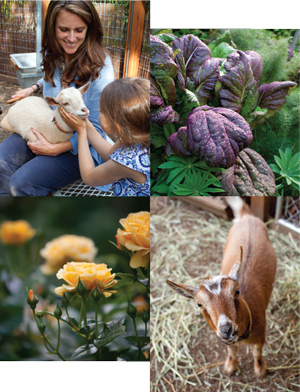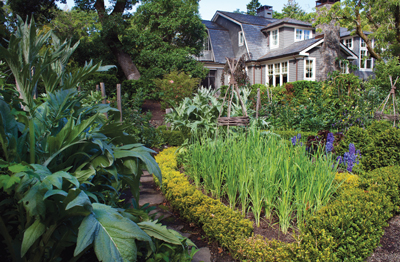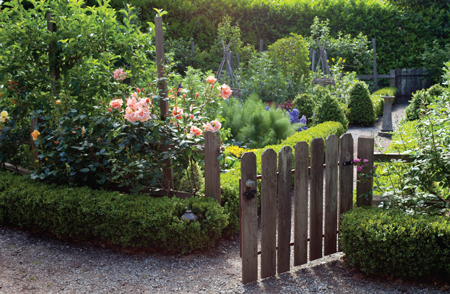Molly Gamble was 10 years old when she first discovered the wild, tangled grounds that, decades later, would become hers. Now the Ross native pays homage to her long-ago secret garden, enjoying it all over again with her husband and two young children. “When I was a child, my friends and I would play in the creek on the border of the property, and we always felt like we had discovered a very special place,” she recounts. Eventually, Gamble adds, she wandered through the winding foliage, or “the great curtains of green,” as she calls them, “to find my way through secret spaces.”
For years, these secret spaces were an unexpected source of fascination, hinting at a forgotten era and presenting a sense of adventure at every turn. “For me, a garden is where imagination comes to life, and this was a garden that really sparked my imagination,” she says thoughtfully. (It also helped spark a career as, years later, Gamble opened Molly Bloom, the popular Kentfield flower shop.)
 At the time, the one-acre Ross garden belonged to the elderly Virginia Voorhees, a distant relative who lived alone on the property and who, Gamble believes, didn’t mind her curious garden visitor. Voorhees was the third — and last — member of her family to make an imprint on the 100-year-old garden. Her grandfather had originally purchased the lot in 1906 for 10 gold coins and established a formal garden with boxwood and yew hedges and a redwood grove. Later, his daughter, Virgnia’s mother, would introduce Japanese plants such as dwarf cypress and camellias.
At the time, the one-acre Ross garden belonged to the elderly Virginia Voorhees, a distant relative who lived alone on the property and who, Gamble believes, didn’t mind her curious garden visitor. Voorhees was the third — and last — member of her family to make an imprint on the 100-year-old garden. Her grandfather had originally purchased the lot in 1906 for 10 gold coins and established a formal garden with boxwood and yew hedges and a redwood grove. Later, his daughter, Virgnia’s mother, would introduce Japanese plants such as dwarf cypress and camellias.
But it’s Virginia’s garden that lives on in Gamble’s memory. “She had a more natural sensibility,” Gamble says, recalling a garden “carpeted in muscari, snowdrops and other springtime bulbs.” This wild acre was a world away from the carefully cultivated garden acre Gamble knew — and also loved — growing up just a few blocks away.
Gamble’s father, Gary Scales, a co-founder of the Marin Rose Society, tended a garden of more than 500 roses and nurtured a large, varied vegetable plot. Here, Gamble’s chore was to harvest produce and flowers for the family’s dinner table. It’s also where she enjoyed the best heart-to-heart talks with her dad.
In 1998, shortly after she married her husband, Mark, the couple casually mentioned to a realtor friend that someday they’d like to have a place like the Voorhees home. “We were looking for a house, but we weren’t in a hurry,” she says now. “We figured we’d have years to look.”
As it turned out, they had less time than that. Just 10 days later, the Voorhees property appeared on the market. “There was a line of people who wanted to buy it,” Gamble remembers. “We overheard people say, ‘We’ll put the tennis court here and the cabana there,’ ” she says. “To them, this was just a flat acre in Ross, but to us it was so rich in history and potential. It was wrenching.”
Gamble notes that she and her husband were drawn to the garden like moths to a flame. “It was a dream of mine to bring the garden back to life,” she explains. So they enclosed a personal letter, and their bid was accepted. “It was the best decision of our life,” she insists. “We never looked back.”
Instead, they looked forward to re-creating a garden that evoked much the same spirit as the one that had earlier captured Gamble’s heart. Her underlying intention, she explains, was “to design a space with aesthetic layers so that children can get lost in the beauty.” And much of that relied on the idea that a good garden unfolds itself. “There are no 90-degree angles here; everything is a turn and a meandering path,” she says.
For help, they collaborated with landscape architect Brian Koch of Terra Ferma Landscapes in South San Francisco. “An amazing quality about Molly’s garden is that it has everything one would want: It’s mysterious, dramatic and functional — and it produces,” Koch points out. “From the eggs in the henhouse to the giant pumpkins and espaliered fruit trees, this garden has it all.”
The vegetable garden references Beatrix Potter books and is the way Gamble “imagines Mr. McGregor would have had a garden.” It’s round, divided into quadrants and planted with cutting flowers and favorite vegetables — lettuce, chard, squash, gourds, green beans, snap peas and, her favorite, fava beans. It also produces giant pumpkins, including the 400-pound specimen that garnered first prize at the Ross Centennial three years ago.
Around the patch’s rustic fence are espaliered apple and pear trees, unusual weeping mulberry trees (again, a reference to an iconic childhood memory) and thornless “Triple Crown” blackberries, “the biggest, fattest blackberries you’ve ever seen,” she says, smiling.
 Nearby, the family’s flock of hens roosts in a large custom coop, a pair of bunnies dozes in a cozy hutch and the two newest residents, a mother-and-son pair of Dwarf Nigerian goats named “Oh No” and “Not Now,” inhabit a roomy enclosure, where they delight visitors.
Nearby, the family’s flock of hens roosts in a large custom coop, a pair of bunnies dozes in a cozy hutch and the two newest residents, a mother-and-son pair of Dwarf Nigerian goats named “Oh No” and “Not Now,” inhabit a roomy enclosure, where they delight visitors.
While the garden gracefully embraces its new influences, Gamble insists that “at its heart, it is a woodland garden,” and to honor its enduring roots, she designed a meditative walk through woodland specimens — yew, madrone, the fragrant Halesia monticola and Sinojackia xylocarpa, and Davidia involucrate. And “because every proper woodland walk should have them, large rhododendrons,” she says. Gamble favors fragrant varieties in white or cream such as Loderi White, Mi Amore, Patricia Marie and Fort Bragg Centennial.
Gradually, the walk opens back up to the larger garden, revealing the wide swath of lawn and a densely planted herbaceous border with two of Gamble’s favorites: the fragrant amethyst-hued Ninebark (Physocarpus opulifolious ‘Diablo’) and the Katsura tree (Cercidiphyllum japonicum). “It’s that same sense of discovery that I remember as a child, wandering around and coming upon something surprising around the corner,” she says after reflection. “That’s the essence of this garden. It’s the sense of discovery every time you’re in it.”


